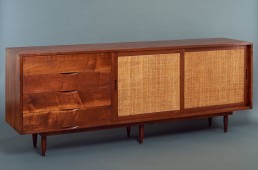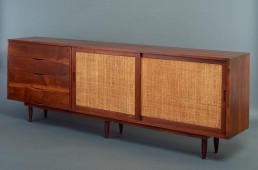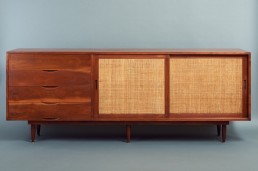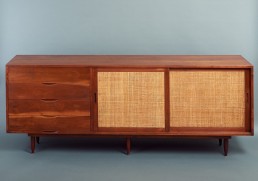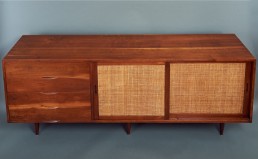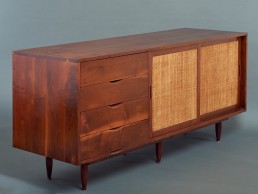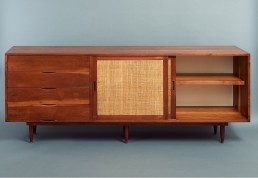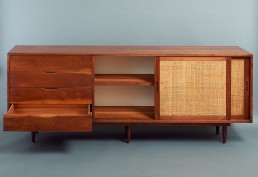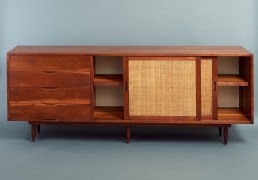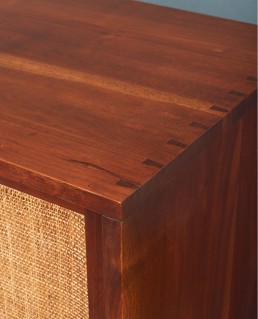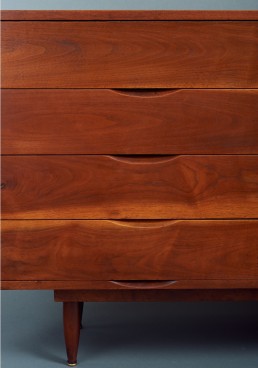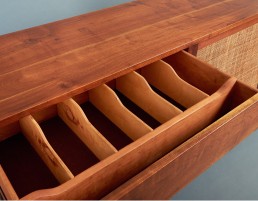Phillip Lloyd Powell Imposing American Craft Cabinet in Walnut and Rattan, c.1960
Phillip Lloyd Powell (1919 – 2008)
A rare and consequential seven-foot long credenza by Pennsylvania Studio Craft Movement master Phillip Lloyd Powell. With a substantial and lustrous walnut frame, two textural rattan sliding doors, four drawers with sinuously carved demi-lune hand-holds, distinctive dovetail construction and detailing, and elegantly rounded and curved doweled legs, all Powell trademarks. A contemporary of George Nakashima and a longtime Paul Evans collaborator, Powell privileged craftsmanship over quantity and limited his career production to fewer than a thousand pieces. Of particular note are his painstakingly hand-carved cabinets, of which this masterly work is a prime illustration.
- Origin: United States
- Period: c. 1960
- Dimensions: 84.25" L x 32.5" H x 18" W
- Materials: Walnut, woven grass matting
- Condition: Very good; wear consistent with age and use
Out of stock
Product Description
Paul Evans was born in Newtown, Pennsylvania in 1931. His talents manifested early: he was the first American to be awarded the George Booth Fellowship, which allowed him to attend Cranbrook Academy of Art in Bloomfield Hills, Michigan. At Cranbrook, he focused his attention on silversmithing, sculpture, and metalwork.
Following a stint spent recreating colonial designs as a silversmith at Old Sturbridge Village Living History Museum near Springfield, Massachusetts, Evans began to spend time in New Hope, Pennsylvania. He was attracted to the vibrant artists’ community, which was supported by wealthy New Yorkers passing through on their way to and from Manhattan. During one of these visits, Evans had the good fortune to become acquainted with Phillip Lloyd Powell, an established furniture designer.
Phillip Lloyd Powell was born outside Philadelphia, Pennsylvania in Germantown, only 40 miles from the Evans family. Powell began making handmade furniture in his family’s basement when he was 16 years old. He entered Drexel Institute of Technology (now Drexel University) and started a course of study in the Engineering program before being drafted into military service in 1938. Trained by the Army as a mechanical engineer and in meteorology, Powell worked for the United States Air Force and later the British Army Air Corps. During his service, he dreamed of leaving the war behind and returning to New Hope to pursue his passion for furniture making.
After being discharged from the military, Powell abandoned his technical training and threw his energies into furniture design. He also bought a book on home design and built his own residence. Soon he established a showroom on a busy thoroughfare and kept shop hours on Saturday nights — often late into the night and early morning — when potential clients were likely to linger in town. His creative approach to sales afforded him a comfortable living and the freedom to control and develop his artistic output.
Evans settled in New Hope in 1955. Within a year, he reconnected with Powell and they began to share a showroom. Drawing on his training as a jewelry designer, Evans began making experimental metal furniture, encouraged by mentor Powell to apply his metallurgy skills to furniture design. Using innovative welding techniques, Evans developed sculpted forms with high-relief, abstract design elements that were collage-like in their construction. In contrast to Evans’ stark welded metal designs, Powell’s work consisted of hand-carved wood forms with a sinewy, organic quality evoking the feel of reinterpreted Art Nouveau. Powell focused especially on cabinetry that was finely executed, both inside and out. His cabinets often featured luxurious silver leaf or fabric lining.
Like Evans, Powell incorporated atypical materials into his designs; metal and local slate appear in his work, along with the occasional found object. Even though Powell and Evans had a penchant for combining unique elements, the results of their endeavors were quite different. For example, while they both incorporated natural cleft slate into their designs, Evans executed Brutalist welded metal cabinets with slate tops, and Powell created elegant, hand-carved wood tables with slate tops. Powell’s engineering training helped Evans turn his fine jewelry-making skills into furniture. Likewise, Evans’ jewelry-making skills helped Powell refine designs born out of an engineering background.
In 1957, the designers exhibited at the Furniture by Craftsmen show at the Museum of Contemporary Crafts in New York. The show included artists whom Evans and Powell had both admired, such as George Nakashima and Wharton Esherick, fellow Pennsylvania craftsmen. Inclusion in this show cemented their place in the American Craft Movement.
Having attracted national attention, Evans assumed the role of head designer for furniture manufacturer Directional in 1964. With Directional, Evans introduced full lines of furniture and was able to reach a far greater audience than his New Hope studio had allowed.
In 1966, after 10 years of collaboration with Powell, Evans relocated his workshop and the close partnership came to an end. By the late 1960s, his creations for Directional had become very popular and he employed up to 80 people to meet the demands of production. Meanwhile, Powell continued to create by hand, often working alone. He produced fewer than 1,000 pieces in his lifetime.
Evans’ Sculpted Bronze works feature an exterior of abstract textured resin covered in atomized bronze. The Cityscape line consists of rectilinear forms entirely covered in a patchwork of high-polished chrome, brass, or a combination of both. Finally, the Argente series, the rarest of all of his work, is constructed of welded steel and aluminum with patinated, etched, and enameled designs.
Through their partnership, Powell’s raw, handmade furniture pieces became artistic jewels, and Evans’ fine jewelry skills transformed raw steel into a new kind of furniture.

